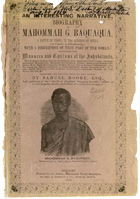Political uses of memories of slavery in the Republic of Benin (1)
Ana Lucia Araujo, Universities of Laval and Ottawa
This article examines how the memory of slavery is constructed and renewed today in the Republic of Benin. By focussing on the official initiatives aiming to promote material and immaterial heritage of slavery, I try to understand the emergence of a new patrimonialization phenomenon, which appears in the construction of public monuments and the creation of new private museums and memorials, especially in Ouidah. Establishing relations between the several monuments and discourses developed by different actors and the representatives of some official institutions will allow us to understand the plural and controversial memories of slavery and the slave trade in Ouidah and its connections with the memory of the African diaspora.
The last two decades have seen a considerable increase of interest in issues connected with memory and the historical past: museums, monuments, and commemorations. This tendency, which some years ago could be observed in Europe and North America, is now also present in Asia, South America, and Africa. Memory can be seen as a 'souvenir' or as a chronicle or comment, coming close to the definition of 'history' as 'the account of a succession of events'. (2) Memory, however, is not just concerned with the past; it is also confronted in the present. Memory impregnates then the urban space, objects and images, by constituting 'places' of the kind identified by Pierre Nora in his Lieux de mémoire. (3)
For many historians like Jacques Le Goff, memory remains a simple source or object of history. In a hierarchical scale, history would correspond to an official account, very often consensual and carrying truth, while memory would belong rather to the scope of imagination, fiction, construction, and would be close to the idea of lie. In this perspective, the historian's role is to make the equation between the 'truth', which one finds in written documents and archives, and the 'lie', found very often in oral testimonies. From this point of view, memory is seen as a kind of oral archive, a representation of the past, of which one has to be suspicious rather than making and attempt to understand its mechanisms. (4) Even if for a long time the concepts of memory and history have been associated and sometimes confused, it is important to establish a clear distinction between both. According to Bogumil Jewsiewicki, history makes recourse to the study of the past in its own time. (5) In contrast, memory is concerned with this relation to time. It can be seen as a property which allows us to bring into the present an event that occurred in another time. Memory, then, is always anachronistic. Memory is constructed as a relation to the past, which is updated in the present. Memory is plural and not static, it changes with time and is conditioned by the relationship between the individuals and the groups in a given society.
The memory of slavery is not only related to victims, those who suffered the effects of imprisonment, deportation, punishments, and forced labour, but also to those who were left behind and to those who ordered the capture of slaves and participated in the slave trade. Even if these different memories of slavery can eventually converge, in many cases they are contradictory. As well as memory, the essence of heritage is transmission. In this perspective, heritage is asocial construction, a set of visible objects invested by signification, which a society gives itself in a particular moment. These objects define and translate the kind of relationships that this same society develops in relation to the past. (6)
To examine the memory of slavery is to work without witnesses. It is to examine fragments and traces from oral testimonies, objects, buildings, images, and tradition. Marianne Hirsch stated that this particular kind of traumatic memory, which appears in subsequent generations and also in different forms of art works, can be also conceived as 'postmemory', a form of memory that 'characterizes the experience of those who grow up dominated by narratives that preceded their birth, whose own belated stories are evacuated by the stories of the previous generation shaped by traumatic events that can be neither understood nor recreated'. (7) If the traces found in oral tradition and material heritage express these different memories of slavery, the work of memory which is manifested in festivals and monuments is related to this postmemory to which Hirsch refers.
The relations between the Kingdom of Dahomey and Brazil have been exhaustively studied, in different periods, by several authors and scholars such as Pierre Verger, J. Michael Turner, and Robin Law. Between 1770 and 1850, a period which includes the period of the illegal slave trade, Brazilian merchants from Bahia went directly to the Gulf of Benin to buy slaves and sell tobacco. (8) During this period, a great number of slaves, especially Hausa and Yoruba people from this region, were deported to Bahia in Brazil. From 1835, freed slaves and their descendants, as well as other slaves who participated in the rebellion of Malês in Bahia, (9) returned to the Gulf of Benin. They settled along the coast, mainly in the regions of present day Togo, Benin, and Nigeria. Back in Africa, these former slaves joined the community of merchants of Portuguese and Brazilian extraction, who had been established in the area since the eighteenth century.
In 1894, Dahomey became a French colony. After independence in 1960, several coups d'etat and changes of government took place in the country. On 26 October 1972, a group of military officers took control of the government and Mathieu Kérékou was named chief of the state. Kérékou installed a military dictatorship, following a pseudo 'Marxist-Leninist' program. At that time, public debates about slavery's past could not happen, because elementary freedoms did not exist. (10)
In 1990, a National Conference led the country to democracy and Nicéphore Soglo was designated interim Prime Minister. (11) A year later, Soglo was elected President of Benin, claiming that Africa needed a new Marshall Plan, which would consist of improved financial assistance to African countries and debt relief. (12) He opened the doors for international capital and started requesting financial support from the World Bank and the International Monetary Fund. In this new context, cultural tourism became a viable alternative to promote the economic development of the region and Atlantic slavery and slave trade became a major issue.
In order to conserve, restore, and promote the heritage of slavery and the slave trade, Benin received the support of different organizations such as the United Nations Educational, Scientific and Cultural Organization (UNESCO), Prevention in the Museums of Africa (PREMA), the International Centre for the Study of the Preservation and Restoration of Cultural Property (ICCROM), and the Getty Institute. By 1992, two projects were being discussed: Ouidah 92 : First International Festival of Vodun Art and Culture and the Slave Route Project, both initiatives commissioned by UNESCO. The Vodun (13) celebration, closely related to the trans-Atlantic slave trade, was strongly supported by the French Embassy and Nouréini Serpos Tidjani, who has been the Prime Minister, the Adviser in cultural affairs, and also the Ambassador of Benin at UNESCO. By promoting Vodun culture, it was hoped that the Ouidah 92 festival would be better accepted by descendants of slaves and slave merchants. Furthermore, the festival would celebrate the new religious freedom established by Soglo. (14)
In contrast, the Slave Route Project initiated by Benin and Haiti in 1991 and supported by UNESCO, (15) aimed to develop a scientific program. This project was sustained by Paulin Hountondji, philosopher and professor at Université Nationale du Bénin, who was president of the temporary international coordination committee and Minister of Culture. Hountondji saw the project as an opportunity to discuss not only the relationship between the Americas and Africa, but also the interaction between the ethnic groups who stayed behind. The Minister wanted Benin to lead the initiative, promoting the memory of slavery, but he argued that religion was not the most appropriate means to establish connections between Africans and its diaspora. (16)
When UNESCO and the government of Benin decided to give priority to the Vodun festival, they made religion a priority, and put the Slave Route Project in danger. Finally, Ouidah 92 and the Slave Route Project were associated and eventually merged. The Vodun festival was held from 8–18 February 1993 in Ouidah, Porto Novo, and Cotonou. The event took place one year before the launching of the Slave Route Project and covered most of the same elements with some distortions. (17) Ouidah 92 had a positive response in local newspapers. International personalities of Afro-American culture such as Pierre Verger, James Brown, and the Brazilian composer and singer (and current Minister of Culture) Gilberto Gil, along with representatives of different authorities, went to Benin to participate to the launch of the festival.
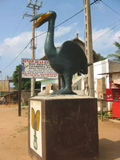
Illustration 1: Cement sculpture by Cyprien Tokoudagba, Slaves' route in Ouidah (Benin). Photograph by the author, 2005.
Larger image (351KB)
A festival like Ouidah 92 would help to promote cultural tourism and to improve the economic activity of Ouidah, which declined in a drastic manner since the beginning of the twentieth century. (18) As part of the commemorations, local authorities decided to rearrange a three-mile route from the town to the beach, which slaves supposedly walked before being embarked to the Americas. One hundred monuments and different memorials remembering slavery and Vodun deities, most of which were conceived by Cyprien Tokoudagba (a well-known Beninese artist, from Abomey) were placed on this route (illustration 1).
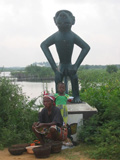
Illustration 2: Cement sculpture by Cyprien Tokoudagba, Slaves' route in Ouidah (Benin). Photograph by the author, 2005.
Larger image (351KB)
The route, passing through different quarters, highlights existing historical sites and Vodun shrines. In the last ten years, at least two hotels, Jardin Brésilien and Casa del Papa, were built on the beach of Ouidah. Many Beninese and foreign tourists visit the Slaves' Route, which is now a place of pilgrimage. However, only locals and researchers are courageous enough to walk along the route, the majority of people visit the Slaves' Route by car or bus. Moreover, every January the Walk of Repentance is held in the city of Ouidah to request forgiveness for all Africans who were sent as slaves to the Americas. The participants of this ceremony are not only the slaves' descendants from Benin and the United States, but they also belong to families of slave merchants' descendants. Once there were many different routes leading to the beach, which were taken by the slaves during the trans-Atlantic slave trade, so that the Slaves' Route can be seen as fiction. (19) Some of the cement sculptures were set on historical sites. However, many of them were placed all along the road in order to reinforce the idea of continuity, without necessarily marking a special point or historical event. (20) Further, the choice of sculptures seems to have been made arbitrarily. Many of them do not have a panel with a historical explanation or a description of the monument, which makes the narrative confusing, or at least less understandable, to visitors. Today, most of the sculptures and memorials are abandoned, although monuments representing Vodun deities are actually used as Vodun shrines by the people living in Ouidah (illustration 2).

Illustration 3: Place Chacha and cement sculpture by Cyprien Tokoudagba, Slaves' route in Ouidah (Benin). Photograph by the author, 2005.
Larger image (271KB)
The first important point of the Slaves' Route is the Place des enchères or Place Chacha (illustration 3), (21) which is located behind Francisco Félix de Souza's compound, is supposed to be situated where the slave market existed in the past. In spite of this, the sculpture marking the square represents an Amazon of Dahomey's army, a female warrior with naked breasts and horns. Possibly, one can argue that the memory of slavery here does not concern only the Brazilian slave merchant. It refers rather to his partner, King Ghezo, who waged military campaigns annually against neighboring kingdoms. After these campaigns, many of the captives were sold as slaves and sent to the Americas. Before going further, it is important to explain who Francisco Félix de Souza was. De Souza was a Brazilian slave merchant from Bahia who settled in the Bight of Benin in the beginning of the nineteenth century to work at the Portuguese fortress and to take part in the trans-Atlantic slave trade. King Adandonzan and de Souza had a quarrel, probably caused by a debt related to the slave trade. The merchant was then brought to prison, but once there he received the aid of Prince Gakpe, Adandonzan's brother, with whom he made a pact to carry out a coup d'etat. (22) As the head of the Kingdom of Dahomey, Prince Gakpe became King Ghézo and de Souza was rewarded for his help by being appointed to an official position in Ouidah, becoming the King's commercial agent in charge of selling slaves. (23) One does not know exactly the origin of the nickname 'Chacha', (24) which became a title, but as the point of departure of the Slaves' Route in Ouidah is situated at the Place Chacha, one cannot deny that the UNESCO project has had a great influence to promote the memory of Francisco Félix de Souza.
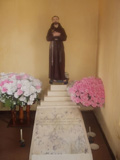
Illustration 4: Tomb of Dom Francisco Félix de Souza (First Chacha), Memorial Dom Francisco Félix de Souza, Singbomey, Ouidah (Benin). Photograph by Alessandra Brivio, 2005.
Larger image (351KB)
The memorial of the old home of the Chacha includes two houses. Each one has a bedroom and a large living room. On the walls, the visitor can see paintings and pictures depicting Francisco Félix de Souza and all the Chachas who succeeded him, pictures of the Dahomey's King, Ghezo, and an appliqué hanging of Abomey symbolizing Dahomey's kings. However, the summit of the visit is when members of the family open the doors of the slave merchant's bedroom. Inside the bedroom the visitor can see the 'Brazilian wood' bed of Francisco Félix de Souza. The bed is made every day, as if he was still alive. Also, inside the room there is his tomb, which is decorated with a statue of Saint Francis of Assisi (illustration 4). Although the de Souza family is said to be Catholic, the different libation rituals and the ceremonies performed to install the chiefs of traditional worship take place in this room up to the present day. (25) These chiefs have been associated with the de Souza family since King Ghezo named Francisco Félix de Souza his intermediary.
One can argue that the rehabilitation of the memory of Francisco Félix de Souza started more than ten years ago when the eighth Chacha, Honoré Feliciano Julião de Souza, was installed. In July 2005, during a meeting with North American visitors, the spokesman of the eighth Chacha emphasized that his ancestor, Francisco Félix de Souza, was a man of action, an untiring worker who defended just causes. 'He spent his strength and wealth without counting in favor of the weak against the strong, the oppressed against the oppressor'. (26) He was described as a well-educated man, who was the grandson of the Brazilian general governor Tomé de Souza and who belonged to a rich family from Bahia. (27) The spokesman also insisted on designating Francisco Félix de Souza as a 'merchant', without mentioning that he was a slave trader. He is mainly presented as the man who introduced the cultivation of the palm oil tree to Dahomey. According to Robin Law, even if these attempts to reconstruct and modernize the memory of Francisco Félix de Souza can be found in different publications about the de Souza family, some accounts of contemporary British travellers also report that the first Chacha considered himself a great philanthropist. (28) Robin Law also explains 'this implicit de-emphasization of the slave trade probably reflects the taking of it for granted, rather than a desire to suppress an unsavory aspect of the family's history'. (29) However, with the rise of the tourism in Ouidah, this reconstruction of the memory of de Souza, could better fit the objectives of official agencies like UNESCO. Instead of remembering the slave past, the de Souza seek to emphasize their Brazilian roots. (30)
Inside the house of the eighth Chacha, visitors can see different objects and pictures related to Brazil. An official portrait of Brazilian President Luis Inácio Lula da Silva decorates the wall opposite the front entrance of the main living room. In February 2006, when Lula went to Benin for the first time, he visited not only Ouidah but also inaugurated the new 'palace', although the building remains unfinished. During his visit, which was intended to develop commercial and cultural partnerships with Africa, the Brazilian President promised: "Never again, will Brazil turn its back on African people'. (31)
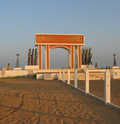
Illustration 5 : The Door of No Return, Ouidah (Benin). Photograph by the author, 2005.
Larger image (351KB)
Many other monuments and memorials can be seen along the Slaves' Route, such as the Tree of Forgetting, the Zomaï Enclosure, the Zounbodji Memorial, and the Tree of Return, all of them constructed for the Vodun festival Ouidah 92. The great Door of No Return (illustration 5), however, located on the beach at the end of the Slaves' Route, and inaugurated in November 1995, is the only monument associated with the Slave Route Project. This impressive monument, designed and ornamented by the Beninese artist Fortuné Bandeira evokes the monumental Soviet aesthetics. The Door of No Return aims to mark the place where slaves were embarked to the Americas. Yves Appolinaire Pédè made the cement bas-reliefs onto the platform and the sculptures depicting the Egun-guns, while the artist Dominique Kouass conceived the four metal sculptures representing the families of captives. Although the bas-reliefs represent slaves in chains—very near to the stereotype—the text engraved on the plate identifying the monument does not mention slavery, slaves, or the Slave Route Project. (32)

Illustration 6: Memorial of the Jubilee of Catholic Church of the year 2000, Ouidah (Benin). Photograph by the author, 2005.
Larger image (218KB)
Since 2000, the construction of two new similar monuments on the beach has influenced the reception of the Door of No Return. The Catholic Church commissioned the construction of a great memorial for the Jubilee of the year 2000 in order to commemorate the arrival of the first Catholic missionaries in Dahomey. The monument's color is exactly the same as the Door of No Return, displaying a great wall that depicts an enormous map of Benin (illustration 6). Across from the monument's interior face (decorated with bas-reliefs representing the Catholic missionaries) there is a big cross in granite, which can also be seen through the wall, from the beach. On the memorial's wall, we can read some passages from the Bible as well as the name of the missionaries. This memorial commemorating the arrival of the Catholic missionaries is the very opposite of the other monuments and memorials, which remember Vodun and slavery. On the one hand, the Catholic Church contributed to the legitimization of slavery and the slave trade and on the other hand, during French rule and still today, representatives of the Catholic Church denounce the traditional religions.
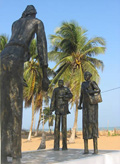
Illustration 7: The Door of Return, Ouidah (Benin). Photograph by the author, 2005
Larger image (361KB)
Two hundred metres away, a second monument named the Door of Return (illustration 7) was set up in 2004 by a non-governmental organization named the Organisation pour la Promotion de Médecines Traditionnelles (PROMETRA). The monument comprises a map of Africa with three bronze sculptures representing the mother receiving her son and daughter. The man and the woman, who are dressed in occidental fashion, seem to come from North America. Those of the African diaspora who visit the museum are invited to bring with them a memento and to leave it in a special room dedicated to the memory of the ancestors who left and were unable to return. The monument and the museum seem to be built for Afro-Americans from the United-States, even if the majority of them are not descendants of slaves, coming from the region of present day Benin.
Fiction or not, the Slaves' Route of Ouidah is a great example of the development of a phenomenon of patrimonialization, encouraged by the UNESCO. The achievements of the Slave Route Project and Ouidah 92 have surely helped to promote the creation of museums and the construction of new monuments, even if they are not exactly related to issues of slavery. In some cases, these new monuments and museums transform the original goals of these official projects, by allowing the emergence of different and conflicting memories. If these monuments were built for Afro-American tourists, today, the local population of Ouidah have incorporated the discourse and duty of memory promoted by UNESCO by creating private museums such as the First Chacha memorial home and The Door of Return's Museum. Several actors, most of them associated with Afro-Brazilian families, have developed different strategies to exploit the memory of slavery for their own benefits. In Ouidah, tourists who make an appointment can visit de Souza's house in order to learn more about the past of the Brazilian slave merchant.
These museums and memorials promote different visions of slavery, contributing to the reconstruction of the memory of slavery in the region, not necessarily from the point the view of those who were sent to the Americas as slaves, but from the point of view of slave merchants, NGOs, and the Catholic Church. The absence of panels with historical explanation in the places where the monuments are located does not help the visitor to learn more about slavery, the slave trade, or Vodun culture, but it sheds light on the existence of conflicting memories of slavery. In addition, everyday people living in Ouidah have transformed the original goal of the Slaves' Route monuments. If the memorials such as Zomaï Enclosure and Zounbodji are totally abandoned, today the local population uses many of these sculptures as Vodun shrines, where people make offerings to the different deities. These different visions of slavery's past in Ouidah show us that despite the UNESCO's supposed efforts to discuss and to promote the memory and history of slavery from the point of view of slaves in the region, these memories remain plural and contradictory.
This phenomenon of patrimonialization, locally appropriated, fits the notion of a postmemory, where museums and monuments are at the heart of a living and dynamic process of creative reinvention of the past. However, although this process highlights plural and sometimes conflicting memories, one can argue that the descendants of slaves and slave merchants try to be unified around a similar discourse favorable to this wave of patrimonialization carried out by the UNESCO and other organizations. By incorporating the discourse of duty of memory and the need to preserve the cultural heritage, the members of the local community also express their desire to fit into a global world and to be themselves part of a Western tradition in which museums and monuments occupy a central place in the cities to attract tourists and to shed light on the importance of African civilizations and cultures in the construction of the Americas and Atlantic world.
Notes:
- I wish to thank to Nadine Hunt for reading and commenting the draft of this paper. Early versions of this paper were presented at the Harriet Tubman Centre Seminar, York University, October 2005 and at the international conference 'Community Building and Identity Formation in the African Diaspora' held at Boston University in March 2007. The research and fieldwork were supported by a grant from the Canada Research Chair on Comparative History of Memory (Bogumil Jewsiewicki, Université Laval, Canada), Fonds Québécois de la Recherche sur la Société et la Culture (FQRSC, Canada), Bureau International (Université Laval, Canada), as well as Fonds de l'enseignement et de la recherché (Université Laval, Canada). Back to (1)
- 'propriété de conservation de certaines informations, [qui] renvoie d'abord à un ensemble de fonctions psychiquesgrâce auxquelles l'homme peut actualiser des impressions ou des informations passées qu'il se représente comme passées' (P. Veyne, 'Histoire' in Encyclopedia Universalis, vol. 3 (Paris), 423–4, quoted by J. Le Goff, Histoire et mémoire (Paris, 1988), 180. Back to (2)
- P. Nora, 'Entre Mémoire et histoire. La problématique des lieux', Les Lieux de mémoire, Vol 1: La République (Paris, 1984), xxiv. Back to (3)
- See Le Goff, Histoire et mémoire. Back to (4)
- B. Jewsiewicki, 'L'actualité de la mémoire et l'émergence du témoin', (Maison Sauger, MSH, Paris, 10 décembre 2003), conference on numerical support, compact disc. Back to (5)
- Krzysztof Pomian quoted by F. Hartog, Régimes d'historicité : présentisme et experience du temps (Paris, 2003), 164. Back to (6)
- M. Hirsch, Family Frames: Photography, Narrative and Postmemory (Cambridge MA., 1997), 22. Back to (7)
- P. Verger, Flux et reflux de la traite des nègres entre le Golfe de Bénin et Bahia de Todos os Santos, du XVIIe au XIXe siècle (Paris, 1969), 7. Back to (8)
- See J. J. Reis, Slave Rebellion in Brazil : The Muslim Uprising of 1835 in Bahia (Baltimore, 1993). Back to (9)
- The only Beninese newspaper during the Revolution was Ehuzu, which became La Nation in 1990. Back to (10)
- In 1975, Dahomey became the Popular Republic of Benin and in 1994 the Republic of Benin. Back to (11)
- 'Face à ces difficultés de plus en plus éprouvantes au niveau des ressources, la plupart des États se sont engagésdans des programmes d'ajustement structurel. Ces programmes ne bénéficiant pas encore des ressources nécessaires au développement de nos économies sinistrées, il nous plaît de réitérer ici notre appel à la communauté internationale sur la nécessité d'un "Plan Marshall" pour l'Afrique afin de redéfinir de façon plus explicite les conditions de financement des programmes d'ajustement Nicéphore Soglo', La Nation (Cotonou, 13 July 1992), 5. Back to (12)
- According to Melville Herskovitz (Dahomey: An Ancient West African Kingdom, Vol 2 (Evanston, 1967), 171), a Vodun is a '... "god", yet within a shrine will point to a particular spot where a large jar is imbedded and will say that the vodu is there. Quite apart from the concept of vodu which regards it as a deity [...] the fact remains that a vodu is also thought by the Dahomean as something which is localized, and that a spirit, while philosophically conceived as existing everywhere in space, must also have definite places to which it can be summoned, where it can be commanded by the proper formulae to aid its worshippers, and from which it can go forth to achieve those things desired of it'. During the Revolution, Vodun religion was forbidden, at least in theory, by the Marxist-Leninist regime. See D. Rush, 'Contemporary Vodun Arts of Ouidah, Benin', African Arts, 34.4 (2001), 32. Back to (13)
- See Rush, 'Contemporary Vodun Arts of Ouidah', 32–3. Back to (14)
- See the Website of UNESCO Slavery Route Project : http://portal.unesco.org/culture/en/ev.phpURL_ID=31553 &URL_DO=DO_TOPIC&URL_SECTION=201.html Back to (15)
- P. Hountondji, 'Le ministre de la culture déclare: "Non, les cultures du Bénin ne sont pas des cultures vaudon"', La Nation (Cotonou, 27 November 1992), 5. Back to (16)
- The Slave Route Project was officially launched in Ouidah with an international conference General Conference of UNESCO, 27th Session, Resolution 27 C/3.13 (1993). In December 1994, another conference was held in Ouidah to launch the project in Benin. Back to (17)
- 'One consequence of Ouidah's marginalization in the twentieth century was that it was not subject to radical redevelopment. There were some important changes: notably the elimination of the office of the Dahomian French fort (now a public square) in 1908. But the basic layout of the town as it existed in the second half of the nineteenth century was preserved; the major colonial developments were added on the town, as an extension of it (to the north-west), rather than disturbing the character of its historical centre' (R. Law, Ouidah: The Social History of a West African Slaving 'Port', 1727–1892 (Athens GA and Oxford, 2004), 12). Back to (18)
- 'Il percorso della Route de l'esclave propone dunque una lettura parziale dello spazio, selezionando solo alcunetrace del passato. Codificando attraverso l'itinirerario ciò un'altra operazione di occultamento : la realtà delle gerarchie sociali del presente. Queste sono leggibli nel tessuto cittadino. Non solo infatti la mappa urbanistica di Ouidah fu ridisegnata completamente dalla tratta, ma anche le diverse aree nella città sembrano corrispondere aidifferenti statuti sociali dei gruppi che vi sono insediati' (see R. Cafuri, In scena la memoria : antropologia dei musei e dei siti storici del Benin (Turin, 2003), 119. Back to (19)
- 'This narrative is both simplified and embellished. The monuments or single sculptures located at the critical sites between the purposed location of the auction block and the beach are engraved with a panel of didactic material Often the histories given and the locations of the sites are not corroborated by or even mentioned in the literature on the subject (Curtin 1969; Manning 1982, 1991; Law 1991). Some generalizations are understandable, for much is truly unknown about the circumstances of the slave trade from the Ouidah port. In other cases the histories seem highly unlikely. The "unknown" of the slave trade, however, is of little importance compared to its "living history"—that is, what the markers say today, as improbable as some of it may seen' (Rush, 'Contemporary Vodun arts of Ouidah, Benin', 42). Back to (20)
- The sculpture was placed on this site in 1993, at the time of the launch of Ouidah 92. However, in 1999, a new plate entitled Place Chacha was placed some metres from the sculpture. According to the plate, the 'restoration' of the place was made possible by the financial support of the Federal Republic of Germany. Back to (21)
- J. M. Turner, 'Les Brésiliens : The Impact of Former Slaves upon Dahomey' (unpublished PhD thesis, Boston, Boston University Graduate School, 1975), 90. Back to (22)
- See A. da Costa e Silva, Francisco Félix de Souza, mercador de escravos (Rio de Janeiro, 2004), 89. Robin Law discusses stressfully the nature of the position of Francisco Félix de Souza. See Law, Ouidah. The Social History of a West African Slaving 'Port', 1727– 1892, 168. Back to (23)
- For some, the word 'chacha' is the equivalent in Fon of cacà, 32 which means 'quick maid' or yet an adaptation of the expression já já used by de Souza and in Portuguese means also 'quickly, quickly'. According to oral tradition, he gained this nickname because when he escaped from prison, the Dahomean guards asked the men who were transporting him what were they carrying and they answered 'a chacha', which means 'mats' (See E. Dunglas, 'Le Chacha F.F. de Souza', France-Dahomey, mai-juin 1949, quoted by Costa e Silva, Francisco Félix de Souza, mercador de escravos, 89; see also note 30. However, we are not sure about this version, because according to Segurola and J. Rassinoux (Dictionnaire Fon-Français (Madrid, 2000), 108, the word 'mat' in Fon language is zàn, which should be related rather to King Adandozan than to Francisco Félix de Souza. Back to (24)
- Interview and visit to the memorial of Francisco Félix de Souza filmed by Ana Lucia Araujo, with David de Souza and Christian de Souza, Singbomey, Ouidah, 24 July 2005 and interview with Honoré Félician Julião de Souza (Eighth Chacha) by Ana Lucia Araujo, Singbomey, Ouidah, 24 July 2005. Back to (25)
- According to the document entitled Discours de bienvenue du porte-parole de son Excellence Mito Honoré Feliciano Julião de Souza, Chacha 8 à la délégation de l'Université de Rutgers (État du New Jersey) (Ouidah, 24 July 2005). Back to (26)
- This improbable version of Félix Francisco de Souza's biography is supported by S. de Souza, La Famille de Souza du Bénin-Togo (Cotonou, 1992). Back to (27)
- London, The National Archives, CO96/4 (Lieutenant-Governor Hill, Cape Coast, 11 November 1844), cited by R. Law, 'The Atlantic Slave Trade in local history writing in Ouidah (Republic of Bénin)', a paper presented at the Conference on Literacy Manifestations of the African Diaspora University of Cape Coast, Ghana, 10–14 November 2003, 10. Back to (28)
- R. Law, 'The Atlantic Slave Trade in local history writing in Ouidah (Republic of Bénin)', 10. Back to (29)
- Final words of Honoré Feliciano de Souza (Eighth Chacha), during the meeting with the delegation of Rutgers University, Ouidah, 24 July 2005. Back to (30)
- 'Nunca mais o Brasil voltará as costas ao povo africano' in 'Presidente Lula percorre "rota dos escravos" de Benim', Terra 'notícias', (10 February 2006, website visited on April 26, 2006) [http://noticias.terra.com.br/brasil/ interna/0,,OI873537-EI1194,00.html]. Back to (31)
- The text engraved in the marble plate is: 'La Porte du Non-Retour a été inauguré le 30-11-95 par le président de la République Son Excellence Monsieur Nicéphore Dieudonne Soglo, Monsieur Federico Mayor, Directeur Général de l'UNESCO, Monsieur Boutros Boutros Ghali, Sécrétaire Général de l'O.N.U, à l'occasion de l'Année 1995, comme année internationale de la tolérance'. Back to (32)

